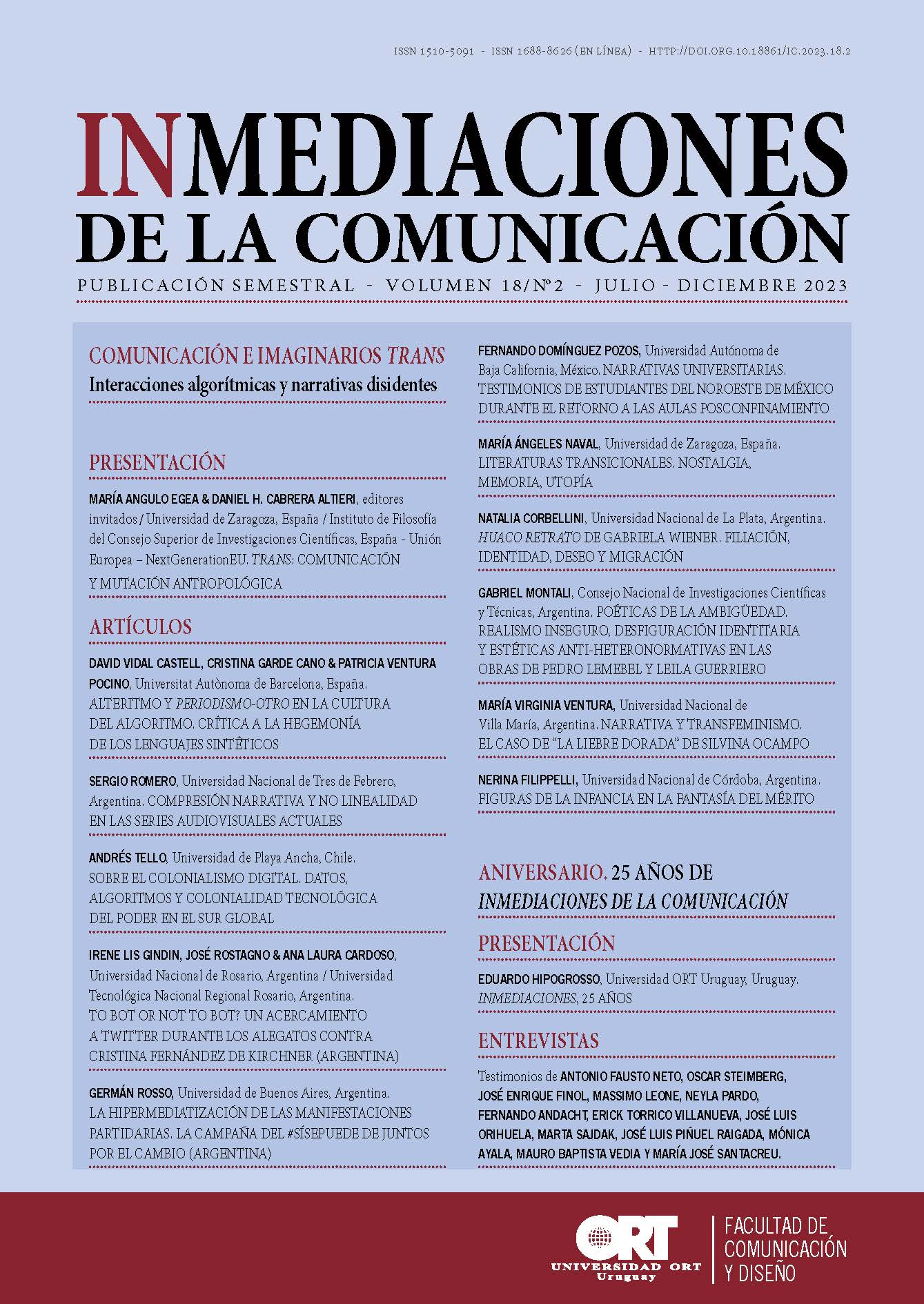Narrative compression and nonlinearity in current audiovisual series
DOI:
https://doi.org/10.18861/ic.2023.18.2.3522Keywords:
narratives, audiovisual, transmedia, series, ShowrunnerAbstract
The article analyzes the changes that have occurred in the narrative strategies used for the writing and production of audiovisual series within the framework of the current transmedia scenario. In this sense, we first refer to the effects produced in the development of the structure and formats of the series, including the appearance of a new role: the Showrunner. Then, we analyze the way in which the changes were complemented by the inclusion of new strategies in the development process and narrative design of the series which mark the transmedia scenario.
Downloads
References
Acuña, F. & Caloguerea, A. (2011). Guía para la producción y distribución de contenidos transmedia para múltiples plataformas. Santiago de Chile: Acción Audiovisual.
Adalian, J. (2015). 10 Episodes Is the New 13 (Was the New 22). Vulture.com. Recuperado de: https://www.vulture.com/2015/06/10-episodes-is-the-new-13-was-the-new-22.html
Aronson, L. (2010). The 21st-Century Screenplay: A Comprehensive Guide to Writing Tomorrow's Films. Crows Nest: Allen & Unwin.
Bennet, T. (2014). Showrunners. The art of running a TV Show. London: Titan Books.
Burman, D. (2016). El Rey del Once. Al borde de la ficción. Buenos Aires: Treinta y seis.
Calvisi, D. (2016). Story Maps: TV Drama. The Structure of the One-Hour Television Pilot. Los Angeles: Act Four Screenplays.
Campanella, J. J. & Castets, F. (2002). Dos años antes… en El Hijo de la Novia. Buenos Aires: Del nuevo extremo.
Caparrós, M. (2016). La crónica. Buenos Aires: Planeta
Carrión, J. (2014). Teleshakespeare. Las series en serio. Buenos Aires: Interzona.
Dahl, R. (2013). Relatos de lo inesperado. Buenos Aires: Anagrama-Página/12.
De la Torre, T. (2016). Historia de las series. Barcelona: Vamos en Series.
Eco, U. (1989). Apostillas a El Nombre de la Rosa. Buenos Aires: De la Flor.
Escobedo, A. (2019). Un fan hace un final alternativo de Game of Thrones que resultó mucho mejor. Codigoespaghetti.com. Recuperado de: https://codigoespagueti.com/noticias/cultura/un-fan-hace-un-final-alternativo-de-game-of-thrones-que-resulto-mucho-mejor/
Epstein, A. (2006). Crafty TV Writing: thinking inside the box. New York: Henry Holy and Company.
Field, S. (1984). El libro del guion. Madrid: Plot.
García Márquez, G. (1998). La Bendita manía de contar. Madrid: EICT / Ollero & Ramos editores.
García Márquez, G. (2004). Cómo se cuenta un cuento. Buenos Aires: Sudamericana.
HPFA - Hollywood Foreign Press Asociation (2015) Golden Globe® Awards Consideration Rules. Recuperado de: https://www.goldenglobes.com/sites/default/files/uploads/2012/04/HFPA-Golden-Globe-Awards-Eligibility-Descriptions-Effective-2-1-15.pdf
Hong, C. (2011). When Did People Start Saying Showrunner? Slate.com. Recuperado de: https://slate.com/culture/2011/10/showrunner-meaning-and-origin-of-the-term.html
Jenkins, H. (2003). Transmedia Storytelling. Recuperado en: https://www.technologyreview.com/2003/01/15/234540/transmedia-storytelling/
Klastrup, L. & Tosca, S. (2004). Transmedial Worlds – Rethinking Cyberworld Design, Recuperado en: https://www.itu.dk/people/klastrup/klastruptosca_transworlds.pdf
Kinder, M. (1991). Playing with Power in Movies, Television, and Video Games: From Muppet Babies to Teenage Mutant Ninja Turtles. Berkeley: University of California Press.
McEwan, I. (1997). Enduring Love. London: Vintage.
McKee, R. (2013). El Guion. Barcelona: Alba.
Pérez, X. (2015). El mundo, un escenario. Shakespeare, el guionista invisible. Barcelona: Anagrama.
Romero Chamorro, S. (2022). Narrar lo Real. Ensayos sobre no-ficción. Mendoza: Blankspot.
Romero Chamorro, S. (2023). Los canales públicos de TV en tiempos de convergencia digital y cultural. Una propuesta marco para su transformación en pos de sus objetivos como Radiotelevisoras de Servicio Público. Mimeo. En prensa.
Ryan, M. L. & Thön, J. N. (Eds.) (2014). Storyworlds across media: toward a media-conscious narratology. London: University of Nebraska Press.
Scolari, C. (2013). Lostology: Transmedia storytelling and expansion/compression strategies. Recuperado de: https://repositori.upf.edu/bitstream/handle/10230/26243/scolary_sem_lostology.pdf
Seger, L. (2017). Cómo convertir un buen guion en un guion excelente. Madrid: RIALP.
Snyder, B. (2006). Save the cat. Barcelona: Alba.






